

So that's rotating it 90 degrees, just like that. Rotate it positive 90 degrees, that side it going to look like this. Seven along the x-axis, it's going to go seven along the y-axis. So what's going to happen there? Well this side, right over here, if I rotate this 90 degrees, where is that going to go? Well instead of going Now if I'm gonna rotate I 90 degrees about the origin, that'sĮquivalent to rotating this right triangle 90 degrees. So let me see if I can, It's I could probably draw, actually I can use a line tool for that. So, it's a right triangle where the line between the origin and I is its hypotenuse. So let's first focus on, actually let's first focus
Graph paper maker 90 degree angle series#
But how do we do that? And to do that, what I am going to do, to do that what I'm gonna do is I'm gonna draw a series Those around the origin by positive 90 degrees. Just focus on the vertices, because those are theĮasiest ones to think about, to visualize. Rotate the points here around the origin by negative 270 degrees, that's equivalent to just rotating all of the points, and I'll That this is equivalent to a positive 90 degree rotation. Get that point here, which we could have also gotten there by just rotating it by And then this would beĪnother negative 90, which would give you in total, negative 270 degrees. This would be rotatingĪnother negative 90, which would, together, be negative 180. The origin by negative, so this is the origin here, by negative 270 degrees, what would that be? Well let's see, this wouldīe rotating negative 90. If you were to start right over here and you were to rotate around So if I were to start, if I were to, let me draw some coordinate axes here. So let's just first thinkĪbout what a negative 270 degree rotation actually is. So actually let me go over here so I can actually draw on it. The points of this triangle around the origin by negative 270 degrees, where is it gonna put these points? And to help us think about that, I have copied and pasted So what we want to do is think about, well look, if we rotate And this tool, I can put points in, or I could delete points. So positive is counter-clockwise, which is a standard convention, and this is negative, so a negative degree would be clockwise. The direction of rotationīy a positive angle is counter-clockwise. So this is the triangle PINĪnd we're gonna rotate it negative 270 degrees about the origin. We're told that triangle PIN is rotated negative 270ĭegrees about the origin. I hope this gives you more of an intuitive sense. If you want, you can connect each vertex and rotated vertex to the origin to see if the angle is indeed 90 degrees. As per the definition of rotation, the angles APA', BPB', and CPC', or the angle from a vertex to the point of rotation (where your finger is) to the transformed vertex, should be equal to 90 degrees. The rotated triangle will be called triangle A'B'C'. The point at which we do the rotation, we'll call point P. Well, let's say the shape is a triangle with vertices A, B, and C, and we want to rotate it 90 degrees. The shape is being rotated! But how do we do this for a specific angle? With your finger firmly on that point, rotate the paper on top. Now place your finger on the rotation point. Put another paper on top of it (I like to imagine this one as being something like a transparent sheet protector, and I draw on it using a dry-erase marker) and trace the point/shape. Here's something that helps me visualize it: The "formula" for a rotation depends on the direction of the rotation. I'm sorry about the confusion with my original message above. If you want to do a clockwise rotation follow these formulas: 90 = (b, -a) 180 = (-a, -b) 270 = (-b, a) 360 = (a, b). Also this is for a counterclockwise rotation.
Graph paper maker 90 degree angle full#
360 degrees doesn't change since it is a full rotation or a full circle. 180 degrees and 360 degrees are also opposites of each other. So, (-b, a) is for 90 degrees and (b, -a) is for 270. The way that I remember it is that 90 degrees and 270 degrees are basically the opposite of each other.


 0 kommentar(er)
0 kommentar(er)
